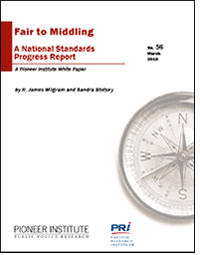This study provides a detailed comparison of the March draft standards being proposed by the Common Core State Standards Initiative (CCSSI) and standards currently in place in states recognized to have high standards—California, Indiana, Massachusetts, Minnesota and Texas.

The report is authored by Stanford University Mathematician Dr. R. James Milgram and Dr. Sandra Stotsky, a member of the Massachusetts Board of Elementary and Secondary Education who in the late 1990s oversaw the creation of Massachusetts’ curriculum frameworks in the English language arts, mathematics, science/engineering, and history and social science.
The CCSSI, which is developing the draft K-12 mathematics and English national standards, was formed in 2009 by the National Governors Association and the Council of Chief State School Officers (CCSSO) to negotiate standards that could be adopted by all 50 states and the District of Columbia. The CCSSI effort has the explicit encouragement of the U.S. Department of Education (USDOE).
Adoption was originally going to be voluntary, but the Obama administration subsequently made adopting the national standards a criterion for receipt of federal “Race to the Top” grant funding. The administration has also floated the idea of making adoption of the new national standards a condition for receipt of federal Title I education funding.
“Early on, the Race to the Top was a set of incentives to advance state reforms that would lift student achievement,” says Jim Stergios, executive director of Pioneer Institute. “The administration’s current course on standards, if they do not undergo serous revision, will instead encourage states to turn their backs on proven reforms.”
Fair to Middling finds that in mathematics CCSSI’s March drafts:
- Include expectations that are too low by the end of the elementary grades
- Delay the development of pre-Algebra skills that are a top priority in high-achieving countries and states, resulting in fragmentary treatment of algebra in the later grades
- Include an idiosyncratic and unproven approach to geometry in grades 7 and 8
- Feature a widely scattered and disorganized treatment of Algebra I, Algebra II, and Geometry
- Common Core’s mathematics standards do not match up well with the top state standards in this country or with the best international standards, but they are more rigorous than the mathematics standards in most states.
Progress has been made in addressing the deficiencies in the January draft of Common Core’s grade-level standards for reading and English language arts, but much more work remains to make its ELA standards as good as those in California, Indiana, Massachusetts, and Texas. The authors write that the most serious problem with Common Core’s ELA standards remains its organizational scheme.
Fair to Middling finds that in English language arts, the March drafts:
- Continue to focus on ten culture- and content-free College- and Career-Readiness standards that are incapable of defining readiness for college reading and generating coherent grade-level academic standards.
- Are organized in a way that renders them unable to serve as a valid or reliable basis for common assessments from grade to grade.
- Include a formula to help English teachers judge the complexity of the literature they teach that is unusable by the average teacher
- Include vocabulary standards in grades 6-12 that are a recipe for reading failure at the high school level.
- Are not benchmarked against high-performing countries
“This analysis demonstrates the inadequacy of the latest draft national standards when compared to California’s rigorous standards,” said Lance Izumi, Koret Senior Fellow and Senior Director of Education Studies at the San Francisco- and Sacramento-based Pacific Research Institute. “If these national standards are forced on states, the winners will be powerful national bureaucracies and special interests, while the losers will be children, parents, high-standards states, and local communities.”
